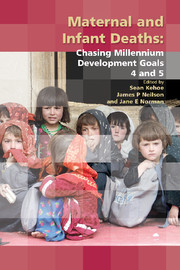Book contents
- Frontmatter
- Contents
- Participants
- Declaration of personal interests
- Preface
- The Millennium Development Goals
- SECTION 1 THE SIZE OF THE PROBLEM
- SECTION 2 CLINICAL PROBLEMS AND SOLUTIONS – MATERNAL
- 5 Postpartum haemorrhage
- 6 Reducing deaths from hypertensive disorders of pregnancy
- 7 Obstructed labour (including partograms)
- 8 Puerperal sepsis in low- and middle-income settings: past, present and future
- 9 Unsafe abortion and strategies to reduce its impact on women's lives
- 10 HIV and tuberculosis
- 11 A pragmatic approach to safe anaesthesia
- SECTION 3 CLINICAL PROBLEMS AND SOLUTIONS – NEONATAL
- SECTION 4 TRAINING AND DEVELOPMENT
- SECTION 5 SPECIFIC CHALLENGES IN SPECIFIC COUNTRIES
- SECTION 6 CONSENSUS VIEWS
- Index
11 - A pragmatic approach to safe anaesthesia
from SECTION 2 - CLINICAL PROBLEMS AND SOLUTIONS – MATERNAL
Published online by Cambridge University Press: 05 February 2014
- Frontmatter
- Contents
- Participants
- Declaration of personal interests
- Preface
- The Millennium Development Goals
- SECTION 1 THE SIZE OF THE PROBLEM
- SECTION 2 CLINICAL PROBLEMS AND SOLUTIONS – MATERNAL
- 5 Postpartum haemorrhage
- 6 Reducing deaths from hypertensive disorders of pregnancy
- 7 Obstructed labour (including partograms)
- 8 Puerperal sepsis in low- and middle-income settings: past, present and future
- 9 Unsafe abortion and strategies to reduce its impact on women's lives
- 10 HIV and tuberculosis
- 11 A pragmatic approach to safe anaesthesia
- SECTION 3 CLINICAL PROBLEMS AND SOLUTIONS – NEONATAL
- SECTION 4 TRAINING AND DEVELOPMENT
- SECTION 5 SPECIFIC CHALLENGES IN SPECIFIC COUNTRIES
- SECTION 6 CONSENSUS VIEWS
- Index
Summary
Background
An estimated 536 000 women die each year owing to complications arising from pregnancy and childbirth. Eighty percent of maternal deaths are due to haemorrhage, sepsis, eclampsia, obstructed labour and complications of abortion. A larger number of women survive with residual complex physical and emotional health problems as a result of such complications. Neonatal welfare is inextricably dependent on maternal welfare. An estimated 4 million neonatal deaths occur each year, three-quarters of which occur in sub-Saharan Africa and South Asia. Inexpensive and simple medical and surgical interventions are recognised to be life saving in the management of these conditions.
The impact and importance of safe anaesthesia in obstetric care
The optimal management of potentially life-threatening complications of childbirth and pregnancy requires anaesthesia or anaesthetic-related skills. In the UK, anaesthetists are involved in the care of over 50% of women in a typical delivery unit.
The most obvious role of the anaesthetist in the obstetric care of women is in the provision of anaesthesia for caesarean section and epidural analgesia for labour but the role goes far beyond this. Anaesthesia may be required to facilitate surgery to gain control of life-threatening haemorrhage that otherwise could become catastrophic, as in women with uterine atony, ruptured uterus, retained placenta or genital tract trauma. Anaesthesia is needed to manage other life-threatening obstetric conditions such as prolapsed cord, obstructed labour and drainage of a septic focus.
- Type
- Chapter
- Information
- Maternal and Infant DeathsChasing Millennium Development Goals 4 and 5, pp. 177 - 184Publisher: Cambridge University PressPrint publication year: 2010



